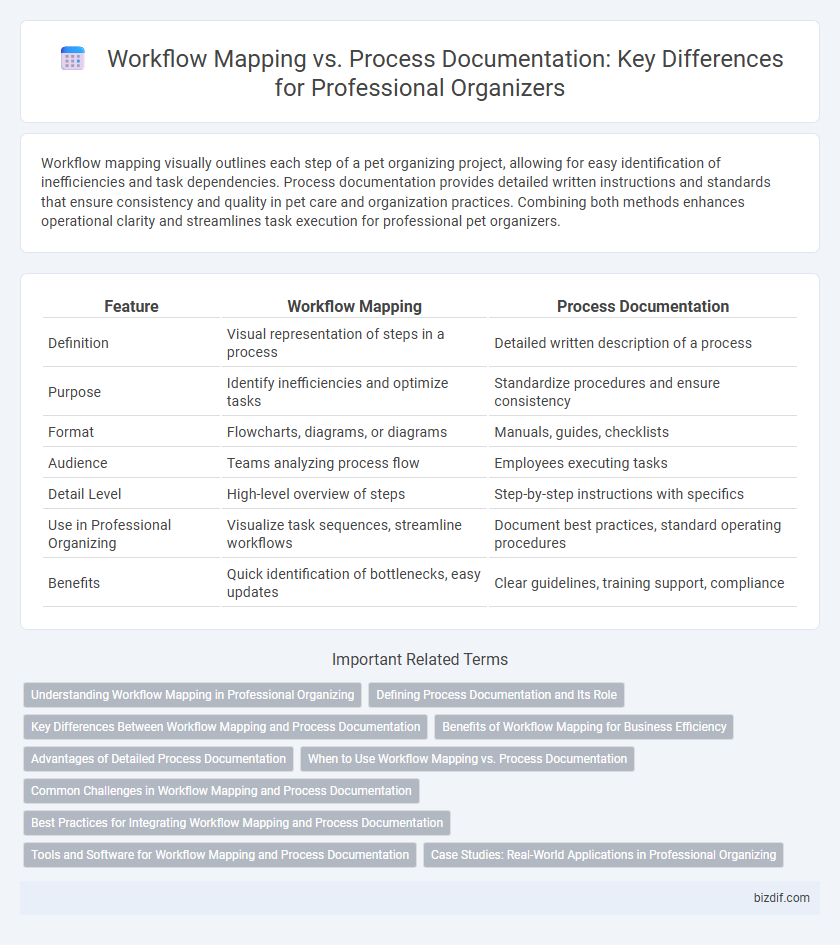Workflow mapping visually outlines each step of a pet organizing project, allowing for easy identification of inefficiencies and task dependencies. Process documentation provides detailed written instructions and standards that ensure consistency and quality in pet care and organization practices. Combining both methods enhances operational clarity and streamlines task execution for professional pet organizers.
Table of Comparison
| Feature | Workflow Mapping | Process Documentation |
|---|---|---|
| Definition | Visual representation of steps in a process | Detailed written description of a process |
| Purpose | Identify inefficiencies and optimize tasks | Standardize procedures and ensure consistency |
| Format | Flowcharts, diagrams, or diagrams | Manuals, guides, checklists |
| Audience | Teams analyzing process flow | Employees executing tasks |
| Detail Level | High-level overview of steps | Step-by-step instructions with specifics |
| Use in Professional Organizing | Visualize task sequences, streamline workflows | Document best practices, standard operating procedures |
| Benefits | Quick identification of bottlenecks, easy updates | Clear guidelines, training support, compliance |
Understanding Workflow Mapping in Professional Organizing
Workflow mapping in professional organizing visually outlines each step and decision point in a process, enabling clear identification of inefficiencies and bottlenecks. This method highlights task sequences and interactions, facilitating a streamlined approach to organizing systems. Effective workflow maps improve project clarity and team collaboration by providing a dynamic, easy-to-interpret guide.
Defining Process Documentation and Its Role
Process documentation involves capturing detailed, step-by-step instructions and resources necessary for completing specific tasks within a workflow. This documentation serves as a reference tool that ensures consistency, facilitates training, and supports process improvement by clearly outlining roles, inputs, and outputs. Unlike workflow mapping, which visually represents the sequence and flow of activities, process documentation provides comprehensive narratives and guidelines essential for operational clarity and accountability.
Key Differences Between Workflow Mapping and Process Documentation
Workflow mapping visually represents the sequence of tasks and decision points to illustrate how work flows through a system, prioritizing clarity and operational steps. Process documentation provides detailed textual descriptions of procedures, roles, and standards to ensure compliance and consistent execution. The key differences lie in format and purpose: workflow mapping emphasizes graphical clarity of task progression, while process documentation focuses on comprehensive, instructional content.
Benefits of Workflow Mapping for Business Efficiency
Workflow mapping visually illustrates each step of a business process, enabling clearer identification of bottlenecks and redundancies. It fosters improved communication among team members by providing a tangible framework, enhancing collaboration and accountability. This clarity accelerates decision-making and streamlines operations, significantly boosting overall business efficiency.
Advantages of Detailed Process Documentation
Detailed process documentation offers clear step-by-step instructions that enhance consistency and reduce errors in professional organizing projects. It facilitates training and onboarding by providing comprehensive reference materials, ensuring all team members follow standardized procedures. This level of detail supports continuous improvement by making it easier to identify inefficiencies and update processes effectively.
When to Use Workflow Mapping vs. Process Documentation
Workflow mapping is ideal for visualizing the sequence of tasks and identifying bottlenecks in complex projects, making it effective during the planning and analysis phases. Process documentation serves best when standardizing procedures and providing detailed instructions for consistent task execution across teams. Use workflow mapping to enhance understanding of overall task flow, while process documentation ensures clarity and repeatability in daily operations.
Common Challenges in Workflow Mapping and Process Documentation
Workflow mapping and process documentation often face challenges such as unclear process boundaries, inconsistent terminology, and lack of stakeholder engagement, which can lead to incomplete or inaccurate representations. Identifying bottlenecks and variations requires detailed observation and validation, complicating efforts to create standardized workflows. Overcoming resistance to change and ensuring continuous updates are critical for maintaining effective and actionable documentation that supports professional organizing goals.
Best Practices for Integrating Workflow Mapping and Process Documentation
Effective professional organizing relies on seamlessly integrating workflow mapping and process documentation to enhance operational clarity and efficiency. Workflow mapping visually outlines all task sequences, enabling identification of bottlenecks, while process documentation provides detailed instructions and standards for task execution. Combining these best practices ensures teams have both a macro-level overview and micro-level guidance, fostering improved collaboration and continuous process optimization.
Tools and Software for Workflow Mapping and Process Documentation
Workflow mapping and process documentation both rely on specialized tools to enhance clarity and efficiency in professional organizing. Popular software for workflow mapping includes Lucidchart and Microsoft Visio, which provide visual diagrams for better understanding task sequences and dependencies. Process documentation benefits from platforms like Confluence and Notion, enabling detailed step-by-step guides and collaborative editing to maintain up-to-date organizational procedures.
Case Studies: Real-World Applications in Professional Organizing
Workflow mapping in professional organizing visually outlines task sequences and relationships, enabling organizers to identify inefficiencies and optimize client environments effectively. Process documentation provides detailed written guides for standard procedures, ensuring consistency and enabling repeatability in organizing services. Case studies reveal that combining workflow mapping with process documentation significantly improves time management, client satisfaction, and scalability in professional organizing businesses.
workflow mapping vs process documentation Infographic

 bizdif.com
bizdif.com